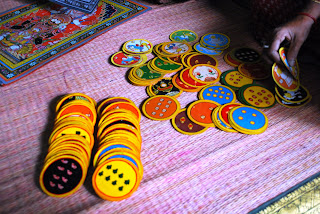I visited the fantastic Raghurajpur handicraft village in Orissa. It was a great experience and this village tops my list of places I would love to go again (no doubt because I adore Indian handicrafts, and the talented artisans of Orissa are renowned for producing some of India's best.
The big attraction at Raghurajpur is that the whole village community is involved in making some kind of handicraft. Many have even won national awards for their work. There are just over 100 households and 300 artisans in the village. Anyone can wander around, check out the beautiful painted murals on the houses, chat to the friendly artisans and see them in action -- and of course their shops-cum-houses.

Pattachitra traditional cloth paintings are a specialty in the village, but the artisans make a wide variety of items including Ganjifa playing crads, palm leaf engravings, stone carvings, masks, wood carvings, and wooden toys. They also do regional art(almost like Warli art) on things like alcohol bottles, clocks, coconut, etc..



The sad part is that the Ganjifa artists have now started practising other form of art than making ganjifa cards. They don't get paid for their hard work.At times, they have to compromise with the price and sell their artwork at lesser price in order to earn a bit of money. The people don;t buy these cards because they are a bit expensive, Rs 2,000- Rs 5,000. It takes the artists more than 5 days to 10 days to complete 1 set of cards with fine work. The artists don't encourage their children to take up this art because their is no money in the art form.
The villagers themselves don't know how to play the game. They themselves play the modern 4 coloured, rectangular cards. They say that the game is tough to play. There are only 3 or 4 old people who actually know how to play this game, the others who knew had died. The artists who make these cards, they also don't know how to play these cards and believe that if they waste their time in playing their game then who will make these cards. On my request, some of them came together to play the dying game. I faced problem in understanding their language because the old men who knew the game properly couldn't talk in hindi or english. But, somehow I did manage to understand the game a bit with the help of others.
I feel there is a need to create awareness among the people about this valuable art which is dying a slow death. I will surely give in my best to save this art form and encourage the other to do the same.






































